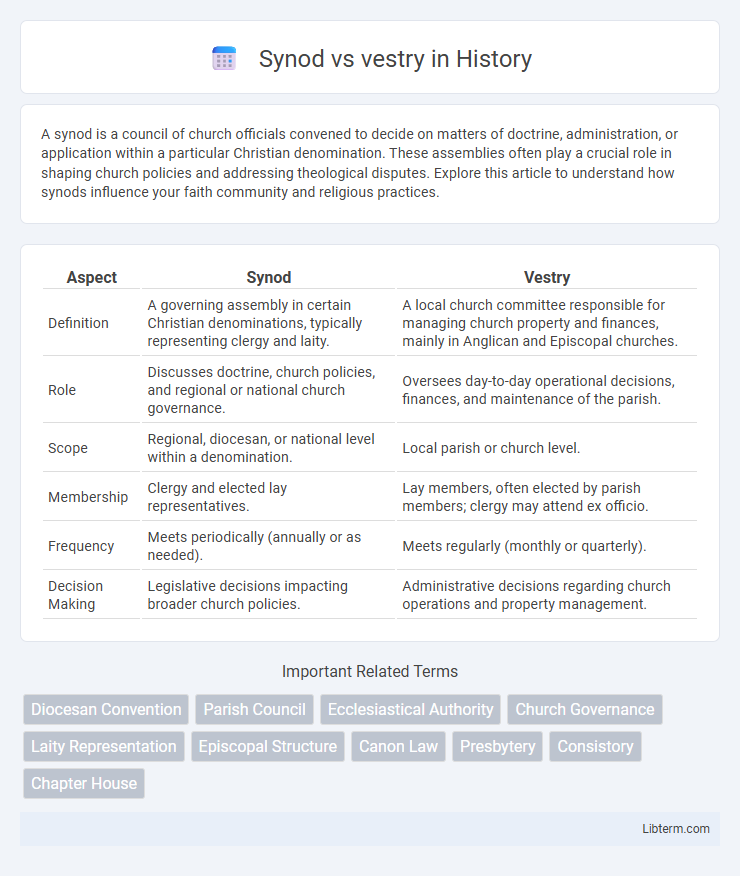A synod is a council of church officials convened to decide on matters of doctrine, administration, or application within a particular Christian denomination. These assemblies often play a crucial role in shaping church policies and addressing theological disputes. Explore this article to understand how synods influence your faith community and religious practices.
Table of Comparison
| Aspect | Synod | Vestry |
|---|---|---|
| Definition | A governing assembly in certain Christian denominations, typically representing clergy and laity. | A local church committee responsible for managing church property and finances, mainly in Anglican and Episcopal churches. |
| Role | Discusses doctrine, church policies, and regional or national church governance. | Oversees day-to-day operational decisions, finances, and maintenance of the parish. |
| Scope | Regional, diocesan, or national level within a denomination. | Local parish or church level. |
| Membership | Clergy and elected lay representatives. | Lay members, often elected by parish members; clergy may attend ex officio. |
| Frequency | Meets periodically (annually or as needed). | Meets regularly (monthly or quarterly). |
| Decision Making | Legislative decisions impacting broader church policies. | Administrative decisions regarding church operations and property management. |
Introduction to Synod and Vestry
Synods and vestries are key organizational structures within many Christian denominations, each serving distinct roles in church governance. A synod typically functions as a council of church officials and lay representatives that convenes to discuss doctrine, policy, and regional church matters. Vestries operate as local church governing bodies responsible for administrative decisions, property management, and financial oversight at the parish level.
Defining Synod: Meaning and Functions
Synod is a formal ecclesiastical assembly comprising clergy and laity that governs doctrinal issues, church policies, and administrative decisions within certain Christian denominations. It functions as a legislative and consultative body, addressing matters such as church laws, worship practices, and disciplinary actions. Unlike a vestry, which typically manages the local parish's temporal affairs, the synod operates at a broader diocesan or regional level, influencing overarching church governance and unity.
Understanding Vestry: Role and Significance
The vestry serves as the governing body of an Anglican parish, responsible for managing church property, finances, and administration. Comprised of elected lay members, the vestry plays a crucial role in supporting the clergy and ensuring the smooth operation of parish activities. Understanding the vestry's function highlights its significance in maintaining church governance and community engagement at the local level.
Historical Development of Synods
Synods originated in the early Christian Church as regional councils convened to establish doctrinal consistency and address ecclesiastical disputes, evolving into formal assemblies representing clergy and laity. Their historical development reflects significant milestones such as the Council of Nicaea in 325 AD, which standardized key theological principles across Christendom. Unlike vestries, which primarily manage parish-level administrative and financial matters, synods hold broader legislative and doctrinal authority within church governance, shaping ecclesiastical policy over time.
Evolution of Vestries in Church Governance
Vestries have evolved from simple local parish meetings into formalized bodies responsible for the administration and financial affairs of Anglican churches, reflecting a shift toward more structured church governance. Historically, vestries managed both spiritual and temporal concerns before the emergence of synods, which introduced broader ecclesiastical representation and decision-making at diocesan and provincial levels. This evolution highlights a transition from localized, lay-led governance in vestries to collaborative structures incorporating clergy and laity in synods, enhancing accountability and church-wide policy formation.
Key Responsibilities: Synod vs Vestry
Synods primarily focus on governance, strategic decision-making, and long-term planning for the broader church community, often shaping doctrine and policies at the diocesan or provincial level. Vestries manage the local parish's temporal affairs, including property maintenance, financial oversight, and supporting parish activities to ensure smooth daily operations. While synods engage in overarching church governance, vestries concentrate on executing and maintaining local church functions.
Membership Structure and Selection
A Synod typically consists of a broad assembly of clergy and laity representatives elected or appointed from various congregations within a diocese or church jurisdiction, ensuring diverse regional or congregational representation. In contrast, a Vestry primarily functions as the governing body of an individual parish, composed mainly of elected parishioners who manage local church affairs, finances, and property. Membership selection in a Synod often involves a formal election process during diocesan conventions or church-wide assemblies, whereas Vestry members are usually chosen by direct election from the local congregation during parish meetings.
Decision-Making Processes Compared
Synods operate as larger ecclesiastical assemblies, typically involving clergy and lay representatives from multiple congregations to deliberate on doctrinal, liturgical, and administrative matters, emphasizing collective governance at the diocesan or regional level. Vestries serve as local church councils composed mainly of elected lay members responsible for managing parish-specific decisions such as property maintenance, budget approval, and local ministry initiatives. While synods employ a more formalized, hierarchical decision-making process reflecting broader church policies, vestries focus on practical, community-based governance with direct accountability to their individual congregation.
Influence and Authority in Church Affairs
Synods hold significant influence in church affairs by representing clergy and laity, making decisions on doctrine, policy, and larger church governance. Vestries typically govern local parish matters, controlling financial decisions, property management, and day-to-day operations within the congregation. The authority of synods often extends across multiple congregations, while vestries operate primarily within individual churches.
Synod vs Vestry: Key Differences and Similarities
Synods and vestries both play crucial roles in church governance, with synods typically functioning as larger deliberative bodies representing multiple congregations, while vestries serve as the local parish's executive committee managing day-to-day affairs. Synods often include clergy and lay representatives who discuss broader doctrinal and administrative issues across a diocese or denomination, whereas vestries focus on parish-specific financial decisions, property management, and local ministry support. Both entities embody shared leadership and collective decision-making, yet synods operate on a regional or diocesan level, contrasting with the vestry's localized parish scope.
Synod Infographic

 libterm.com
libterm.com